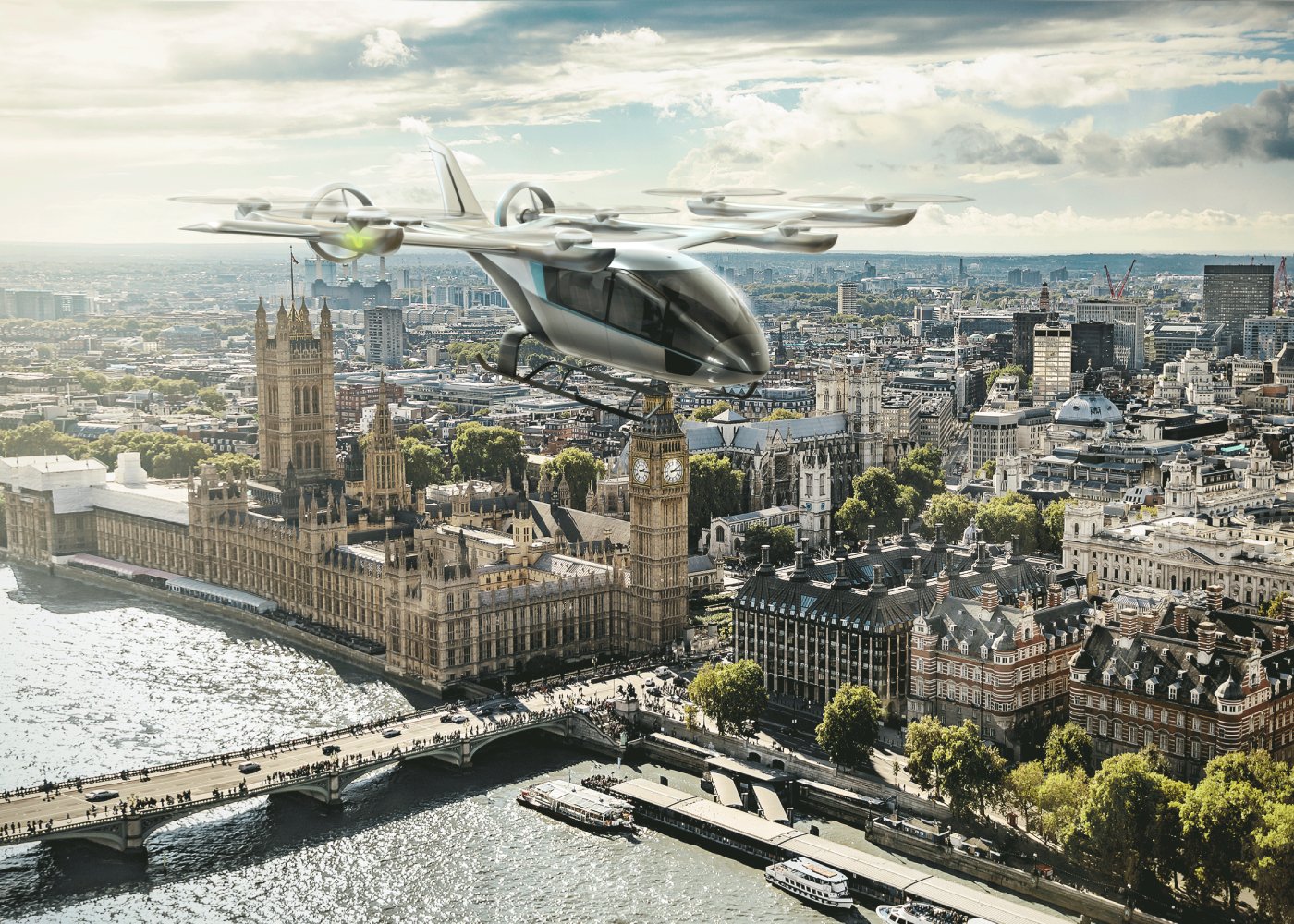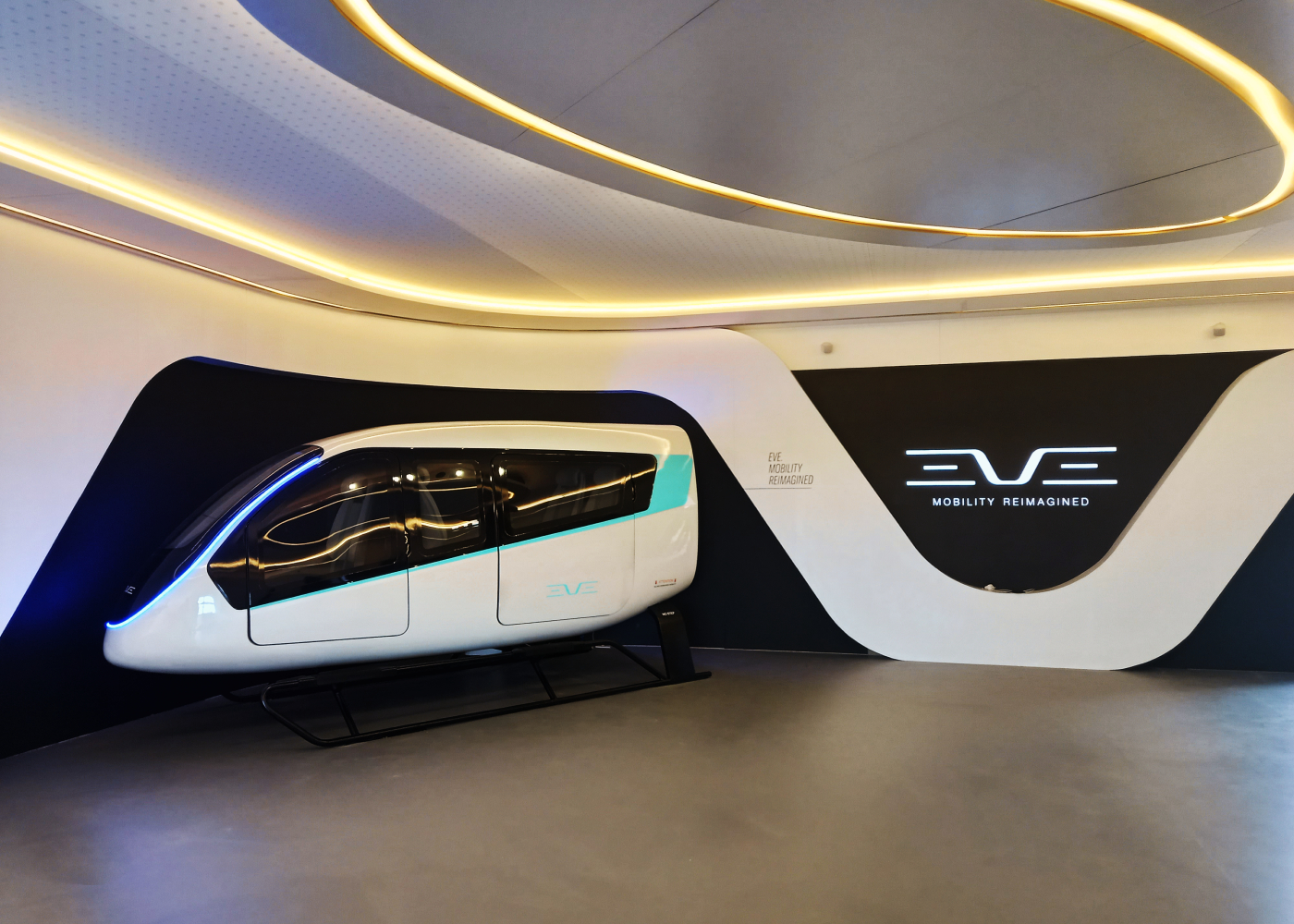Embraer-backed Eve Air Mobility unveiled its eVTOL cabin at the Farnborough International Air Show last week, showcasing a full-size cabin mock-up completed with the sustainable materials Eve hopes to use in the actual aircraft.

The simple four-passenger and one-pilot cabin is specifically designed to be utilitarian yet modern. Once urban air mobility (UAM) evolves to accommodate autonomous operations, the interior can be expanded for six passengers.
“Our interior is a human centered-design, built to serve both a wider diversity of users and urban air mobility operators,” said Flavia Ciaccia, vice president of user experience at Eve. “We knew a successful UAM solution must welcome a diversity of people, all passengers with different lifestyles, not just VIPs. This is the complete opposite of a VIP transport. We want to open new places for people that they perhaps didn’t travel to on the ground because of distance, traffic, or time to get there. This is an alternative transportation for everyone.”
Indeed, the interior is reminiscent of public rail transportation with its utilitarian yet sustainable finishes. The floor is made of 98% sustainable rubber, the seats are natural leather, and cork is used as a thermal and acoustic insulator. Currently, it features two seats facing forward and two seats aft. Ciaccia said the seats are designed to slide forward, providing space behind them to add luggage and other cargo.
Response to the mock-up at the show was positive with Eve gathering valuable feedback on the design. Ciaccia said that two points raised in the past were addressed with this mock-up — sustainability and feasibility — and the company received positive feedback at the show about achieving both goals. While this isn’t the final mock-up, she said it is very close. The mock-up will be displayed at other events around the world in the near future, giving Eve an opportunity to gather more input to put toward a more final design.
Additionally at the show, Eve unveiled an updated aircraft design. Gone is the former two-wing canard configuration in favor of a conventional wing and tail for a simplified lift-plus-cruise design. The single wing contains eight rotors for vertical take-off and landing while two tail-mounted propellers provide thrust for cruise. This update was described by the company as part of ongoing product development to produce an ideal and feasible aircraft for a diverse range of users and operators.

The company is still keeping its plans for when a full-size demonstrator will be completed and when it will begin test flights close to the chest. Eve co-CEO Andre Stein describes the focus of the project as “crawl, walk, run” as it moves toward its 2026 delivery goal. It has been performing ground tests with a proof-of-concept that does not look like the final vehicle and hopes to eventually flight test it. However, this is all Stein would share.
“We are continuously fine-tuning, designing and testing,” he said. “With each step, we determine the project can continue forward. If we rushed into a full-size prototype and make the investment before working through all the steps, we would have to go back to the drawing board. So, we are not disclosing our middle milestones. We are staying focused on the end goal.”
More than eVTOL
In addition to an eVTOL design, Eve has been deeply involved in leading development of an urban traffic management system for future UAM. Built from current air traffic management software designed by Atech, also a subsidiary of Embraer, the system will integrate low-level UAM traffic into national air traffic control systems while also increasing direct point-to-point efficiency for flights.
“There are many places in the world that have air traffic systems, but they are very inefficient for UAM,” Stein said. “There are very few places that have the system capable of handling large numbers of low-level traffic efficiently. We are working on making it much more efficient and capable of being scaled in a safe way as the demand grows through partnerships using our air traffic control management software. The software integrates current air traffic with drones and UAM, creating procedures that are more efficient for low-level operators. You cannot just develop an electric air taxi and expect it to work in today’s system. We want to make sure we are creating the right set of products, including aircraft and air traffic management, to ensure the success of UAM.”
Eve leads the U.K. Urban Air Mobility Consortium to advance this work, a collaboration between the global UAM industry and aviation authorities. In partnership with the U.K. Civil Aviation Authority (CAA) Innovation Hub, the consortium is working to develop an integrated and scalable UAM air traffic ecosystem that helps aviation authorities navigate infrastructure, regulations, technologies, airspace design, and aircraft types.

In March, the consortium announced the completion of a concept of operations (CONOPS) for airspace integration of UAM in the U.K. through the U.K. CAA Innovation Hub’s regulatory sandbox. To test the feasibility of its CONOPS, the consortium is developing a use case transporting passengers from London City Airport to Heathrow Airport with stops in between.
Simulation and modeling in the CONOPS are expected to generate data that identify regulatory gaps and challenges, potential separation standards for electric air taxi operations, efficacy of dedicated flight corridors, design considerations for airspace solutions, and airspace capacity with growing electric air taxi operations.
Eve is also supporting the Advanced Mobility Ecosystem Consortium, which includes Vertical Aerospace and Virgin Atlantic. This consortium is working on a two-year project to develop and test an advanced air mobility (AAM) network in the U.K. The consortium recently received £9.5 million (US$11.4 million) from the U.K. government’s Future Flight Challenge to achieve this goal, and Vertical Aerospace announced at Farnborough it will start aerial ridesharing demonstration flights for this project as early as spring 2024.
Eve is working with Skyports and NATS to incorporate its urban air traffic management software into the network the consortium plans to develop as a part of the project.








